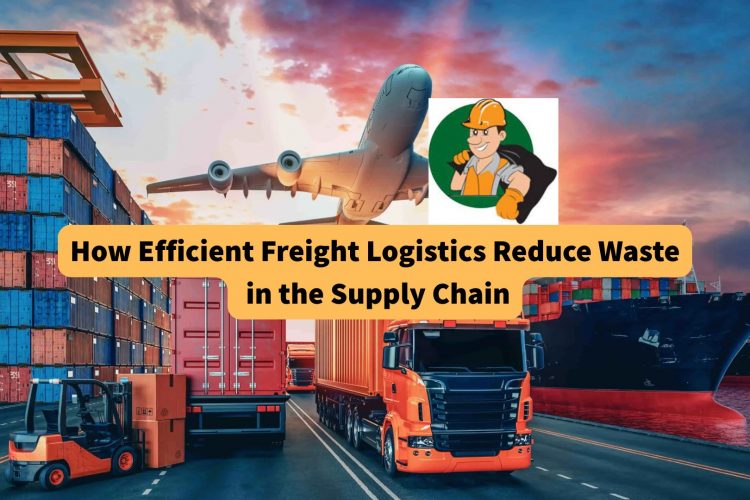Efficient freight logistics are a game-changer for reducing waste in the supply chain. By fine-tuning routes, maximizing load capacity, and keeping track of shipments, businesses can cut down on fuel, unnecessary trips, and overstocking. The result? A smoother, greener, and more cost-effective operation.
So, if you want to know more about efficient freight logistics and help reduce waste in the supply chain, you can continue reading this article for more ideas.
#1 Why Freight Logistics Matter
Here are some of the reasons why freight logistics matter:
- Connects the World – Freight logistics help move goods from producers to consumers, to make sure that product will reach their destinations quickly and cost-effectively.
- Impact on Costs – Efficient logistics help lower transportation costs, which affect the price of goods and a country’s ability to compete globally.
- Keeps Supply Chains Running Smoothly – Logistics can help guarantee that materials and products move through each stage of the supply chain, which can help avoid shortages or overstocking.
- Uses Different Transport Methods – Logistics manage different ways to move goods—trucks, ships, trains, and planes—to ensure that products will arrive on time.
- Drives Innovation – New technologies like real-time tracking and automation help reduce waste, cut costs, and make transportation more eco-friendly.
#2 Common Types of Supply Chain Waste
As supply chains get more complicated, hidden waste can sneak in and hurt profits. By spotting and fixing these types of waste, businesses can save money, improve efficiency, and deliver better value to customers.
1. Overproduction
Making too much or making things too early leads to excess inventory, higher storage costs, and products that might go out of date. This happens when demand forecasting is off or production pushes ahead too soon.
2. Waiting
When materials, info, or people are waiting for the next step, it slows everything down. Machine breakdowns, poor scheduling, or delays in approvals all cause waiting, which wastes time and increases lead times.
3. Transportation
Unnecessary movement of goods between locations costs more and risks damage. And poor layouts and inefficient routing are often the causes of this waste.
4. Inventory Excess
Having more stock than needed ties up money, takes up space, and risks spoilage. Extra inventory often hides problems in the process.
5. Motion
Unneeded movement of workers or equipment wastes time and can lead to tiredness or injuries. For example, workers walking long distances for tools.
6. Overprocessing
Doing more work than needed or adding extra features can waste time and resources. This could be extra checks, redundant steps, or making things more complex than necessary.
7. Defects
When products don’t meet quality standards, they need rework or replacement. This raises costs and hurts customer satisfaction.
8. Non-Utilized Talent
Not using employees’ skills, ideas, or experience is a missed opportunity. Empowering staff and encouraging new ideas can help reduce this waste.
#3 Smart Moves: How Freight Logistics Cut Waste Across the Supply Chain
Modern freight logistics, like FTL freight shipping, is changing how supply chains work by fixing problems at every step. Here’s how it all works:
Cutting Waste with Smarter Routes
Optimizing delivery routes is a great way to save fuel, time, and cut carbon emissions.
With smart route planning, software looks at traffic, delivery times, and truck capacity to pick the best paths. This helps avoid empty miles, cuts down on detours, and gets goods to their destination faster and greener.
The Power of Full Loads and Fewer Trips
Maximizing truck capacity and combining shipments can also help reduce waste.
When trucks are full, fewer trips are needed, which can save fuel, labor, and maintenance costs.
Techniques like backhauling, where trucks pick up return loads instead of driving empty, can help boost efficiency and cut emissions. At the same time, working with other businesses to share loads can also lower costs and make deliveries more efficient.
Tracking Shipments to Avoid Overstocks
Real-time tracking and inventory systems help businesses see exactly where their goods are. This makes it easier to forecast demand accurately and keep inventory levels just right.
By avoiding overstocking, companies can save on storage costs and reduce the risk of products becoming outdated.
Tracking can also help businesses by quickly adjusting to changes in demand, which can cut waste and improve efficiency.
Less Packaging, Less Waste
Packaging creates a lot of waste in the supply chain. And by using less material, choosing reusable or recyclable options, and training staff on efficient packing, businesses can cut down on excess packaging and avoid product damage.
This helps reduce waste, lower shipping costs, and create a better experience for customers.
Tech Tools That Can Help
Digital tools like AI, IoT, and advanced analytics are changing the game in freight logistics.
They help predict demand, automate route planning, and track shipments in real-time. And by using these technologies, companies can spot inefficiencies, solve problems faster, and make smart decisions to reduce waste and boost sustainability.
#4 Some Quick Tips for Cleaner Freight Logistics
Cleaner freight logistics can help your efficiency, protect cargo, and boost your company’s reputation. So, here are some tips that you can apply:
- Clean High-Traffic Areas First – Focus on aisles, exits, and loading zones where dirt and debris build up. Keeping these areas clear avoids accidents and makes moving goods smoother.
- Schedule Regular Cleaning – Create a cleaning schedule that includes daily cleaning and deeper sessions. This helps keep both everyday messes and hidden buildup under control.
- Use Proper Cleaning Tools and Train Staff – Ensure your team has the right tools and proper training. Because well-maintained equipment and trained staff can help guarantee a thorough cleaning.
- Set Up Waste Management Systems – Organize waste sorting, recycling, and disposal of hazardous materials. This keeps your workspace neat and meets environmental rules.
- Clean Cargo and Vehicles – Inspect and clean vehicles and cargo holds before loading. This prevents cross-contamination and keeps your transport vehicles looking professional.
- Respond Quickly to Spills – Have a plan ready to deal with spills or leaks. Because a quick action can prevent damage and keep goods safe.
- Maintain Good Ventilation – Regularly clean and service ventilation systems for clean air and a healthy work environment for everyone.
- Keep Cleaning Records – Document all cleaning and inspections to let you track areas for improvement.
- Create a Clean Culture – Get all employees involved in cleanliness efforts. And an ongoing education can help make everyone play their part in keeping the operation clean.
#5 FAQs
What are the risks of neglecting cleanliness in logistics?
Neglecting cleanliness can lead to contamination, product damage, delays in shipping, safety hazards, and failure to comply with regulations. This can result in fines, customer dissatisfaction, and loss of business.
How do cleanliness practices help prevent contamination in food logistics?
In food logistics, cleanliness is critical to preventing contamination. Regular cleaning of cargo holds, vehicles, and handling equipment makes sure that food products remain safe for consumption and meet the regulatory standards.
How does a clean logistics facility improve employee productivity?
A clean and well-organized workspace helps reduce distractions, minimizes the risk of accidents, and promotes a healthier environment, all of which lead to increased focus, fewer sick days, and higher overall productivity.
#6 The Bottom Line – Wrapping Up: Waste Less, Ship Smarter
Efficient freight logistics is about more than just moving goods—it’s about cutting waste wherever possible.
By using smart strategies like optimizing routes, consolidating loads, tracking shipments in real time, and using sustainable packaging, businesses can save money, reduce their environmental impact, and build customer trust.
Shipping smarter is no longer optional—it’s essential for staying competitive. Companies that reduce waste today will lead the way tomorrow, offering faster, cleaner, and more reliable services.













